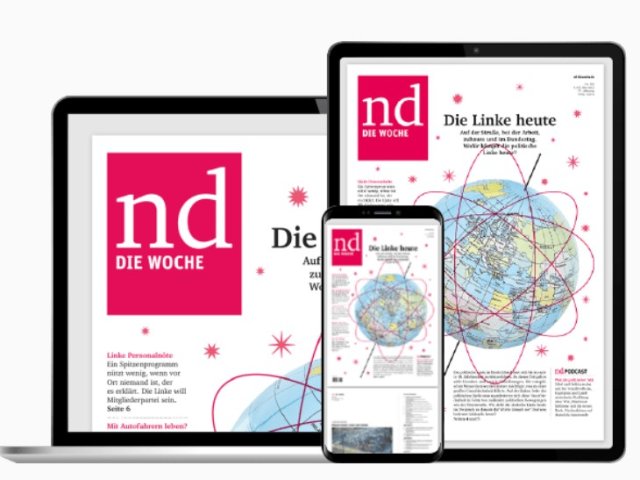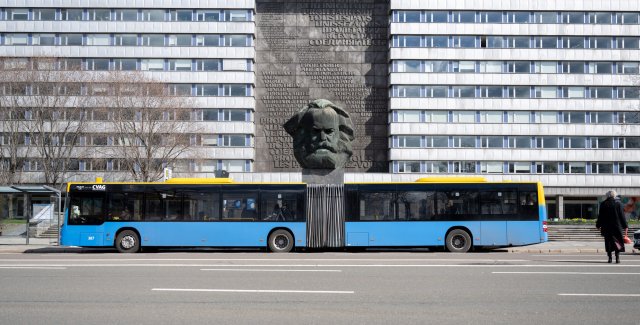If Karl Marx had known this: Chemnitz no longer needs so many buses.
Photo: dpa
In the spirit of the unique “Clarion” chime, with which the message “Thoughts are free” is played live from the Chemnitz town hall tower, eleven scientists had the opportunity to express their thoughts on the topic over three days last week at the University of Chemnitz. Karl Marx City. “Architecture and urban development in an international and historical context”. The colloquium was organized by the municipal art collections and the TU and took place in the university library. It should help raise the profile of Chemnitz, which will become European Capital of Culture in 2025 – along with Nova Gorica in Slovenia. For 37 years, the third largest city in Saxony was named after the philosopher. Before the end of the GDR, in June 1990, it was reverted to its old name after three quarters of its residents voted for it.
The announced contribution by Thomas Flierl, including the former Berlin Senator for Culture for the PDS, was omitted. It would have been helpful if the organizers had used Flierl’s approach to the speakers present, “to understand what has become in both formerly separate Germanys under the specific conditions of its creation and use” and specifically “before we can judge what it is worth practically and culturally today and in the future whether and how it can be appropriated – or not” is particularly important. This might have added added value to the majority of the lectures, which could lead to truly helpful and valid expertise on the problems facing the designated Capital of Culture.
Two presentations stood out. The lecture by Hilde Strobl (archivist for building.art.history at the University of Innsbruck) was met with great applause: “The Neue Heimat – a union construction company in the Federal Republic of Germany 1950–1982”. The speaker provided evidence that this union company not only wanted to write architectural history through urban development, but also explicitly wanted to exert a “societal-shaping influence,” meaning that what was and is being accused of planners in the East could be observed in the West.
In addition, even the union group could only plan and complete the approximate fulfillment of the large demand for housing with the use of the “West German Plate”, i.e. with rational construction and assembly. In 1968, the largest non-state housing construction group in Europe employed one in twelve construction workers in the Federal Republic of Germany and expanded worldwide, from Monaco to Mexico. The Neue Heimat then prepared its own end according to the system: through greedy financial fraud on an unimaginable scale.
The comprehensive “deconstruction” of old buildings is still regretted in the West today and could only be thwarted selectively, but with spectacular success through civil society protests. In the east, for example in Chemnitz, there are still opportunities to prevent demolitions through planning and building policy – perhaps parallel to a new paradigm shift.
In this sense, the final lecture by Thomas Morgenstern (head of the lower monument protection authority in Chemnitz from 1990 to 2020) on “Dealing with the architectural heritage of the GDR after 1989” was conclusive. The eyewitness’s real focus was on the “period of upheaval, which led people to question everything that was reminiscent of the GDR” – for political reasons. No speaker had previously commented on this.
As an example, Morgenstern presented the issue of monument protection for the Chemnitz “bus station,” which is still discussed today and is, at first glance, a technically and aesthetically spectacular building. Planned and built in 1969, the buses were the main means of transport for 30,000 passengers from the surrounding area every day. The 50 percent decline in passengers after the fall of the Berlin Wall had made 16 of the 20 bus lanes inoperable due to unemployment and migration. To this day, the discussion about other availability of the property with the listed, unique Eastern modern building continues to flare up again and again. There is no question that it is one of the Chemnitz eye-catchers. But how long can monument protection hold out against this? The topics of the conference will be the subject of an exhibition in 2025.
Subscribe to the “nd”

Being left is complicated.
We keep track!
With our digital promotional subscription you can read all issues of »nd« digitally (nd.App or nd.Epaper) for little money at home or on the go.
Subscribe now!
judi bola online link sbobet akun demo slot judi bola
